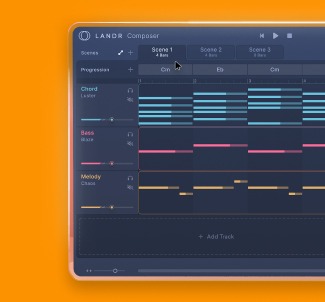
Chord Inversions: How to Write Better Chord Changes
If you’ve ever wondered how the best artists make the simplest chord progressions sound so good, part of the reason is their expert use of chord inversions and voice leading.
Chord inversions re-arrange the notes in a chord by changing the note found at the bottom of the chord. A triad, for example, can be played in root, second and first inversion.
They also help reduce the space between notes in a chord change, creating a smoother sound that doesn’t distract with jarring jumps between large intervals.
In this article, let’s explore how chord inversions work and how to use them to make pleasing chord progressions.
I’ll even share some tips and tools to help you learn how to write better chord progressions of your own.
Let’s dive in!
How do chord inversions work?
Chord inversions re-arrange the order of notes of a chord from top to bottom, changing the position of the chord’s root note.
Triads, the most basic chords, make a great start for understanding how inversions work. They are composed of three notes: the root, the third and the fifth.
A triad can be played in three inversions: root position, first inversion and second inversion.
Each of these inversions places a different note at the bottom of the chord by moving around its root note.
Let’s explore how each of these inversions works in more detail.
Root position
For any chord, its root position always uses its root note at the bottom of the chord.
For example, a C major triad in root position will feature the note C in the bass at the bottom of the chord.
Its remaining notes, E and G, are stacked on top of the note C.
First inversion
In first inversion, the third of the chord will find itself at the bottom, with the root note moved up an octave.
So using the C major triad as an example, the second inversion will use its E note at the bottom with G and C stacked on top.
Second inversion
Second inversion builds the chord on top of the fifth note, with the root and third notes moved up an octave.
In a C major triad, the note G will be found at the bottom of the chord with E and C stacked on top.
Third inversion and beyond
First and second inversion are the easiest starting point for understanding inversions, but you can create further inversions with more complex extended chords that have notes other than the third and fifth.
Every time an extra interval like a 7th or a 9th is added to a chord, an extra inversion of that chord will also be possible.
For example, major 7th chords in third inversion place the 7th at the bottom of the chord, major 9th chords in fourth inversion place the 9th note at the bottom of the chord and so on.
How to use chord inversions?
Chord inversions may seem like a minor, unimportant detail, but the truth is you can use them to make your music sound better through a variety of methods.
With the help of LANDR Composer, our new chord progression generator, I’m going to show you how inversions are used for various purposes in music.
Keep chord changes closer together
If you only use root chords in a chord progression, the changes between each chord tend to jump around.
In some cases, this may be a desired effect, but if every chord change requires a significant jump in intervals, it can sound jarring and distract from your melody.
Inversions can help limit these jumps and make your chord progressions flow smoothly
Here’s an example of how a chord progression with inversions can help let your melody shine through.
In both versions, I’ve generated a i-III-VI-VII minor chord progression in C with a melody on top.
However, in the first version, I’ve only used root chords, resulting in a chord progression that keeps jumping higher in pitch both in the chords and in the bass.
The climbing sound arguably distracts from the melody and the chords could transition more smoothly.
In the second version, I changed the III chord into a second inversion, putting a Bb in the bass underneath an Eb major chord.
I’ve also changed the VII chord into a first inversion, putting a D note underneath a Bb major chord.
As you can see on the MIDI roll, this keeps the notes in each chord much closer together and it doesn’t sound like the chord progression is climbing up the keyboard.
Instead, the changes are much smoother and less distracting, allowing the melody to shine through.
Make a chord progression more interesting
Using inverted chords can also make a chord progression much more interesting, especially when building chords with jazzy extensions like 7ths, 9ths, and 11ths in your chords.
That’s because using inversions can help make chords sound crunchier and more interesting by highlighting slightly dissonant intervals that give jazz chords their signature sound.
Here’s an example of a chord progression with extended chords that I’ve arranged with the help of inversions.
If you couldn’t tell, I’ve used the same chord progression as the one in the example above, but I’ve added 7th, 9th and 13th extensions to each chord.
Then I used inversions to make the chords more interesting, adding major and minor second groupings to make the chords crunchy and pleasantly dissonant.
You can see this on the MIDI roll based on how closely the notes are bunched up using minor and major second intervals.
Create movement in a bassline
Chord inversions are also great for controlling movement between chord changes, especially in the bass.
While the note played in the bass traditionally defines the chord, inversions circumvent this rule, creating movement and interest in a bassline without changing the overall chord progression.
The technique works well when applied over longer chord progressions, and you can see why in this example.
In this vi-ii-I-V-vi-iii-II-II chord progression, I thought it would be interesting to use a descending and ascending theme in the bassline.
Even though the chord progression hardly follows an ascending or descending pattern, I was able to create an ascending sound in the bass with the help of inversions.
LANDR Composer helped with finding the right inversions to arrange bass notes of the chord progression in such a pattern because it was easy to see what effect each inversion choice would have on the arrangement of the chord.
The inverse of boring
Inversions are a great way to add depth and complexity to your chord progressions.
They’re easy to use and can make a big difference to your overall sound.
With a little practice, and the help of tools like LANDR Composer, you can use inversions to write better music and elevate your songwriting to the next level.
Now that you know how to use inversions to write better music, try it for yourself!
Gear guides, tips, tutorials, inspiration and more—delivered weekly.
Keep up with the LANDR Blog.







